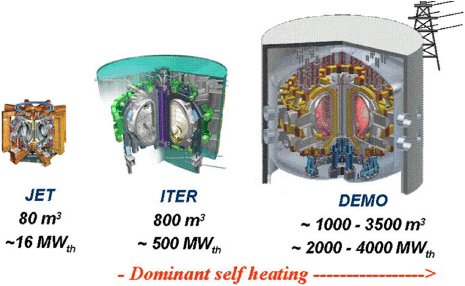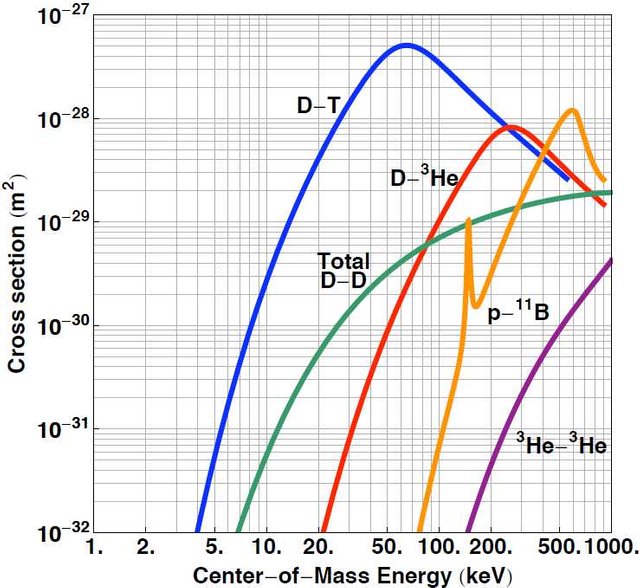Science Series about Fusion: Part 4 - The Future of Fusion
It is time to start the last part of the Science series on the topic of fusion. In this last part, as the title suggests I will be focusing primarily on the topic what lays ahead of us in the field of fusion. I will also talk about some of the possible solutions for the problems I described in Part 4 of this series.
As I have already talked in my previous post, the research of fusion as an energy source started after Russian scientists developed a working reactor in the middle of the 20th century. They knew they must not contain this new concept, because it had grand implications on how the human-kind will produce the energy it needs to fuel its rapidly growing civilization. Both countries, then at "war" (it was the time of the Cold War) started an unprecedented collaboration that developed into ITER.
ITER is a proof-of concept tokamak. Its aim is to produce ten times the energy we must put in to heat up the plasma. This has never been done before! The break-even point has been reached in today purely experimental tokamaks like JET (Joint European Torus) but for more produced energy, the scale must be much larger. We can see the difference in sizes between JET and ITER in Figure 1.

The comparison in size between JET, ITER and DEMO. Taken from [1].
We can also see the first commercial reactor named DEMO in the picture to give you a sense of scale. With the size change, of course the produced power also changes, which is our goal. But this of course brings with it new challenges, because the flux of the plasma on the wall will be incomprehensible from todays point of view. This also means that no material available today will be good enough to contain the stress caused by the super hot plasma.
The reactor DEMO will start construction after ITER has been completed and after it is prooved that fusion is viable. It is supposed to be built around 2060. But unfortunately this date will probably pushed back. A lot!
For perpective... ITER has been in construction for 10 years, as construction began in 2007. Because of political delays and lack of funding it curently on the half-way point even-though first plasma should be ignited a couple of years ago. Today the first plasma is supposed to be ignited in 2025. We must realize that here we are not only fighting nature itself, but also human greed that knows no bounds. Whenever politics gets involved everything slows down. But because almost all develped countries are involved, politics is simply necessary!
A time-lapse of ITER construction!
One must also realize that the research on different alternatives to the now standard tokamak + divertor concept has not stopped. Because of simplicity I will only talk about 2. But I might come to this topics in some later posts. So keep tuned!
Tokamak + Liquid Divertor
This concept is a possible direct answer to the huge heat loads on the walls in the divertor region of the DEMO reactor.
The basic principle is actually pretty simple. Scientists propose a coating of special metals on a standard tungsten divertor base. This special metals must have the fundamental property that if the coating is eroded it is promptly deposited after the reactor is shut down.
In practical terms this means the following. High heat fluxes impact the surface of the coating. The coating absorbs the tritium and the neutrons just as tungsten would.
While the reactor is operating, soon all of the coating is eroded into the plasma, which liberates the trapped tritium into the plasma. Because the operation times of a reactor are very short it does not penetrate deep into the plasma. When the reactor is then shut down all of the material of the coating falls back onto the tungsten and renews the coating layez, without the retained tritium. Sounds pretty cool.
In the fusion circles right now the relevant materials are tin (Sn) and lithium (Li). They posses, as far as we know, the correct properties, but further tests must still be made. A lot of tests to be clear! Li also has another advantage. When a neutron hits the Li there is a possibility of a nuclear reaction where tritium is produced. This would mean such a Li blanket would also "breed" tritium into the plasma.
Aneutronic fusion
I have actually mentioned other fusion reactions, but I have intentionally been a bit hush-hush on them. We can see the relevant in Figure 2.
More relevant fusion reactions. Taken from [2]
As I have already explained the very hard problem of nowaday fusion is containing the neutron produced in the D - T reaction. For right now we have excepted the issue and dealt with it in such a way that the neutron is absorbed in the wall which heats it up. This heat is eventually turned into water steem (steam actually!!!) that drives the turbines of the power plant. An age old, standard process. But aneutronic fusion aims to change it.
This kind of fusion uses reactions that do not produce neutrons. There is one such reaction on the graph actually. It is the p + B reaction. In this reaction only three helium cores are produced. They can be much more easily manipulated so the conversion of their energy into steam is much easier. Also the fusion fuel in this reaction is completely harmless.
Well you might ask: "Why are we not using this then?" The answer is simple. The temperature of the plasma needed for this reaction to occur must be 10 times bigger than the D - T fusion. This means we have no available materials that contain such conditions. But with new materials being found almost every day, aneutronic reactions will probably be the future!
It is finally this time to end this series. I have a couple of spare hours today so I better get this thing done. I must say I really enjoyed all of your support. It really meant a lot to me to see the number of upvotes I get after I work hard to make every post quality content. Do not despair though. More topics will come and I will make more series based on physics. I will make sure they are just as good as this one. Thank you!
If you like the content please upvote and follow me for future content. For more information on me or this series you can check the announcement of this series. If you want to know more about me you can check my introduction post.
Please tell me your opinion on my post and on fusion! All criticism is welcome and wanted. Also if you have any questions feel free to ask them, I will surely try to answer them!
Big thanks to @steemstem for allowing me to use their tag, name and banner in the following series. SteemSTEM is a community driven project which seeks to promote well written/informative Science Technology Engineering and Mathematics postings on Steemit. For more information on the SteemSTEM project join their steemit.chat.
.png)
.png)
.png)



You describe complicated things in simple and understandable language. Thanks you!
Thank you very much. I hope I was as understandable as possible. Did you read all four parts?
Now I have read it! And I envy you. White envy)))
Hahahahah that makes me smile. Why do you envy me? :)
You have an interesting job. Your future depends on your work.
Congratulations! This post has been upvoted from the communal account, @minnowsupport, by maticpecovnik from the Minnow Support Project. It's a witness project run by aggroed, ausbitbank, teamsteem, theprophet0, someguy123, neoxian, followbtcnews/crimsonclad, and netuoso. The goal is to help Steemit grow by supporting Minnows and creating a social network. Please find us in the Peace, Abundance, and Liberty Network (PALnet) Discord Channel. It's a completely public and open space to all members of the Steemit community who voluntarily choose to be there.
If you would like to delegate to the Minnow Support Project you can do so by clicking on the following links: 50SP, 100SP, 250SP, 500SP, 1000SP, 5000SP. Be sure to leave at least 50SP undelegated on your account.